
Wheat: Overview
Wheat is the most
widely produced food crop in the world. In the United States, 42 states
grow wheat and Kansas is the highest producing state. In 1997, Kansas alone
grew enough wheat to bake six-and-a-half loaves of bread for every person
in the world. To learn more about the daily activities of Kansas wheat
farmers, visit The
Kansas Wheathearts' Wheat Mania Site.
 Wheat
is divided into two 'types'--winter and spring. Winter wheat is planted in the fall, remains dormant
through the winter, and is harvested in the spring. It is the primary
type of wheat grown in Kansas. Spring wheat, which is more often grown
in northern states, is planted in the spring and harvested in the fall.
Each of these two types of wheat is further divided into 'classes.' There
are six classes of winter and spring wheat grown in the United States.
Hard red winter wheat is the largest class of wheat produced and exported
from this country each year. To learn more about the classes of wheat,
visit the Minnesota
Association of Wheat Growers. Photo:
Wheatheads at harvest time. Photo courtesy of Wheat Mania.com.
Wheat
is divided into two 'types'--winter and spring. Winter wheat is planted in the fall, remains dormant
through the winter, and is harvested in the spring. It is the primary
type of wheat grown in Kansas. Spring wheat, which is more often grown
in northern states, is planted in the spring and harvested in the fall.
Each of these two types of wheat is further divided into 'classes.' There
are six classes of winter and spring wheat grown in the United States.
Hard red winter wheat is the largest class of wheat produced and exported
from this country each year. To learn more about the classes of wheat,
visit the Minnesota
Association of Wheat Growers. Photo:
Wheatheads at harvest time. Photo courtesy of Wheat Mania.com.
Within each of the six classes of wheat, there are several 'varieties.' Each variety has specialized characteristics. For example, one variety might have extreme disease resistance, while another has a high protein content. Farmers try to plant the varieties best suited for their particular farms so that they can grow the most wheat on the smallest amount of land at the lowest cost, thus maximizing their profits. Therefore, choosing the right variety can be the most important part of increasing crop yield, according to The University of Georgia's Intensive Wheat Management Site.
Even with the best choice of variety, growing wheat can still be a challenge. Farmers must supply their crops with enough nutrients and protect them from diseases, insects, weeds, and severe weather. Other important factors that affect the yield of wheat crops include temperature, the amount of water available, and even the concentration of carbon dioxide (CO2) in the air.
Overview
..|..
Nutrients ..|..
Temperature
..|..
Precipitation
..|..
Carbon
Dioxide
Glossary ..|..
Related
Links ..|..
References
|..
PBL
Model
Home ..|.. Teacher Pages ..|.. Modules & Activities
HTML code by Chris
Kreger
Maintained by ETE
Team
Last updated November 10, 2004
Some images © 2004 www.clipart.com
Privacy Statement and Copyright © 1997-2004 by Wheeling Jesuit University/NASA-supported Classroom of the Future. All rights reserved.
Center for Educational Technologies, Circuit Board/Apple graphic logo, and COTF Classroom of the Future logo are registered trademarks of Wheeling Jesuit University.
